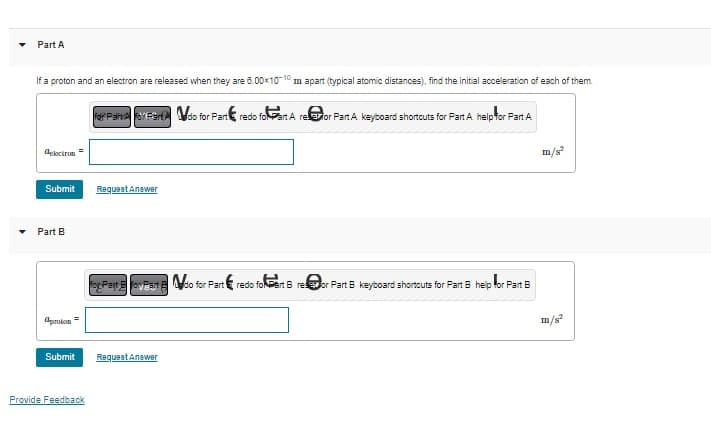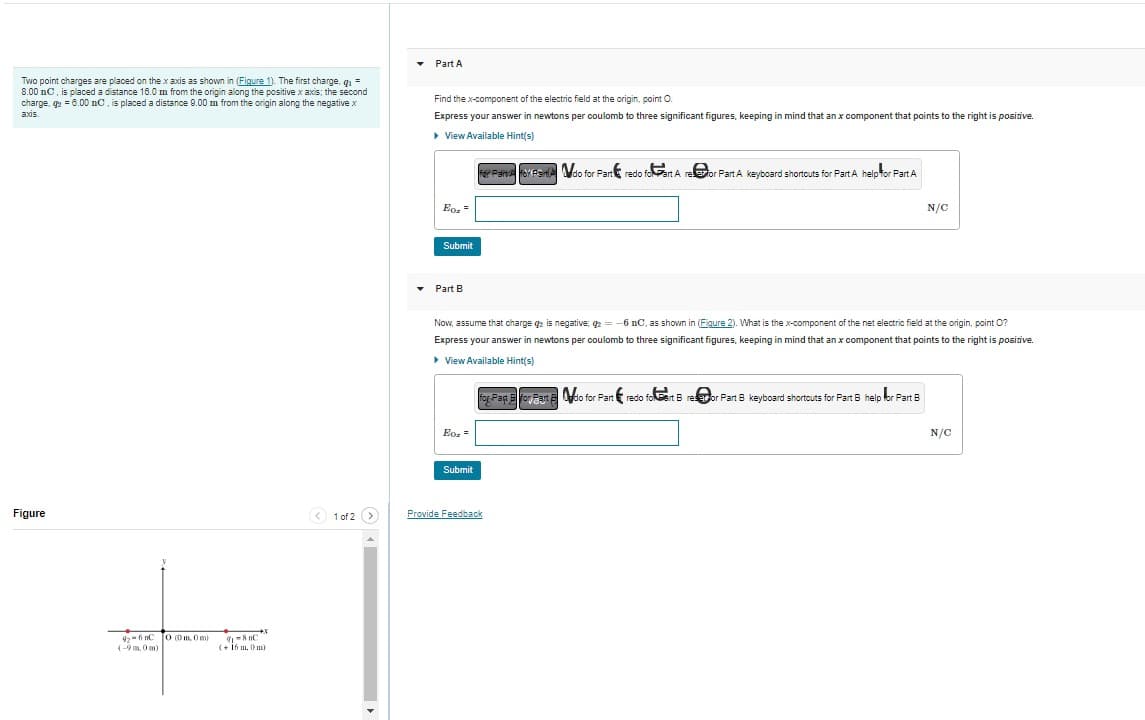Part A If a proton and an electron are released when they are 6.00x10-10 m apart (typical atomic distances), find the initial acceleration of each of them. Pandor Fando for Part redo foart A reor Part. A keyboard shortcuts for Part A help for Part A Submit Part B Request Answer For Part Elevest Vo for Part redo for 6 reor Part 8 keyboard shortcuts for Part 8 help for Part 6
Part A If a proton and an electron are released when they are 6.00x10-10 m apart (typical atomic distances), find the initial acceleration of each of them. Pandor Fando for Part redo foart A reor Part. A keyboard shortcuts for Part A help for Part A Submit Part B Request Answer For Part Elevest Vo for Part redo for 6 reor Part 8 keyboard shortcuts for Part 8 help for Part 6
Physics for Scientists and Engineers with Modern Physics
10th Edition
ISBN:9781337553292
Author:Raymond A. Serway, John W. Jewett
Publisher:Raymond A. Serway, John W. Jewett
Chapter25: Capacitance And Dielectrics
Section: Chapter Questions
Problem 30P: An infinite line of positive charge lies along the y axis, with charge density = 2.00 C/m. A dipole...
Related questions
Question

Transcribed Image Text:Part A
If a proton and an electron are released when they are 6.00x10-10 m apart (typical atomic distances), find the initial acceleration of each of them.
for Paine For Fando for Part redo foart A reor Part A keyboard shortcuts for Part A help for Part A
Submit Request Answer
Part B
aproton
Submit
Provide Feedback
for Part ovest do for Part
Request Answer
redo foart Breor Part B keyboard shortcuts for Part 8 help for Part B

Transcribed Image Text:Two point charges are placed on the x axis as shown in (Figure 1). The first charge. q₁ =
8.00 nC, is placed a distance 16.0 m from the origin along the positive x axis; the second
charge. q2 = 6.00 nC, is placed a distance 9.00 m from the origin along the negative x
axis.
Figure
6 of
9₂-6nC
(-9 m.0m)
0 (0 m, 0 m)
→
₁8 nC
(+ 16 m, 0 m)
< 1 of 2 >
Part A
Find the x-component of the electric field at the origin, point O.
Express your answer in newtons per coulomb to three significant figures, keeping in mind that an x component that points to the right is positive.
▸ View Available Hint(s)
for Paine For Fart do for Part redo foart A refor Part A keyboard shortcuts for Part A help for Part.A.
Eoz
Submit
Part B
Now, assume that charge q2 is negative; 92 = -6 nC, as shown in (Figure 2). What is the x-component of the net electric field at the origin, point O?
Express your answer in newtons per coulomb to three significant figures, keeping in mind that an x component that points to the right is positive.
▸ View Available Hint(s)
for Part 3 forvaart do for Part redo folert B reor Part 8 keyboard shortcuts for Part 6 help for Part B
Eoz =
Submit
N/C
Provide Feedback
N/C
Expert Solution
This question has been solved!
Explore an expertly crafted, step-by-step solution for a thorough understanding of key concepts.
This is a popular solution!
Trending now
This is a popular solution!
Step by step
Solved in 2 steps

Knowledge Booster
Learn more about
Need a deep-dive on the concept behind this application? Look no further. Learn more about this topic, physics and related others by exploring similar questions and additional content below.Recommended textbooks for you

Physics for Scientists and Engineers with Modern …
Physics
ISBN:
9781337553292
Author:
Raymond A. Serway, John W. Jewett
Publisher:
Cengage Learning

Physics for Scientists and Engineers
Physics
ISBN:
9781337553278
Author:
Raymond A. Serway, John W. Jewett
Publisher:
Cengage Learning

Physics for Scientists and Engineers: Foundations…
Physics
ISBN:
9781133939146
Author:
Katz, Debora M.
Publisher:
Cengage Learning

Physics for Scientists and Engineers with Modern …
Physics
ISBN:
9781337553292
Author:
Raymond A. Serway, John W. Jewett
Publisher:
Cengage Learning

Physics for Scientists and Engineers
Physics
ISBN:
9781337553278
Author:
Raymond A. Serway, John W. Jewett
Publisher:
Cengage Learning

Physics for Scientists and Engineers: Foundations…
Physics
ISBN:
9781133939146
Author:
Katz, Debora M.
Publisher:
Cengage Learning

College Physics
Physics
ISBN:
9781938168000
Author:
Paul Peter Urone, Roger Hinrichs
Publisher:
OpenStax College

Physics for Scientists and Engineers, Technology …
Physics
ISBN:
9781305116399
Author:
Raymond A. Serway, John W. Jewett
Publisher:
Cengage Learning

College Physics
Physics
ISBN:
9781285737027
Author:
Raymond A. Serway, Chris Vuille
Publisher:
Cengage Learning